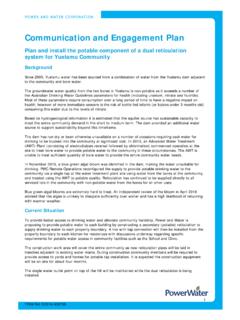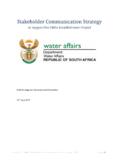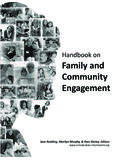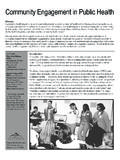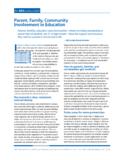Transcription of Communications & Community Engagement Strategy & …
1 Communications & Community Engagement Strategy & action Plan 2012 -2016 FINAL Version 9 Document History Document Location This document is only valid on the day it was printed. The source of the document will be found in folder: F:\Police Authority\Transition Revision History Date of next revision: Revision Date Author Summary of Changes 14 February 2012 10 October 2012 Siobhan Weightman Deputy Chief Executive Revision Date Contributors Summary of Changes 14 March 2012 Nyama Johnson Best Practice update 19 March 2012 David Plews Engagement , Principles and Actions 21 March 2012 Katy Bambridge Consultation Survey Results 23 March Amanda Dodds Additional Strategic Aim 24 March 2012 Barbara Brewis Additions 26 March 2012 Nyama Johnson Translating into Actions April 2012 Sarah Harris / George Osbourne Voice Connect April 2012 Sarah Harris / Dave Coxon Cover IT Live June 2012 Sarah Harris Description of Strategic Objectives Additions to Best Practice, Engagement Recommendations and inclusion of timeline.
2 1 August 2012 Katy Bambridge Integration of Stakeholder Feedback from Stakeholder event hosted on 20 June 2012 Approvals This document requires the following approvals: Name / Organisation Date of Issue Version Local Transition Board 5 September 2012 Distribution This document has been distributed to: Name Date of Issue Version Draft Communications & Engagement Strategy 2012-2016 Table of Contents 1. 2. The role of Police and Crime 6 3. Strategic 4. We Asked, You Meeting the needs of the 9 Meeting the needs of 12 5. Guiding 14 Community 14 Information 14 14 Capacity 14 14 6. Best 16 Policing Priority 17 Police Authority Stakeholder 17 Intergenerational 17 Police Authority Community 18 Talking Together 19 Police and Communities Together (PACTS).
3 20 Area action Partnerships (AAPs).. 20 Safer Neighbourhood Units (SNUs).. 21 21 Cover IT Live (Peterlee).. 21 Voice 22 Safe Durham Partnership - Public Awareness 22 Social 22 7. Moving Forward Recommendations & Draft action 8. Engagement Cycle and 3 Draft Communications & Engagement Strategy 2012-2016 1. Purpose This draft Community Engagement Strategy and action Plan aims to support the new Police and Crime Commissioner (PCC) from day one of entering Public Office on the 22 November 2012. It aims to assist the new PCC to effectively engage with members of the public including the vulnerable and victims, Community groups, police and crime strategic partners and other relevant stakeholders. To inform this Strategy and its supporting action plan, a public consultation exercise was conducted in February 2012 with residents of County Durham and Darlington.
4 The consultation results have contributed towards the evidence base of this Strategy ; providing an indication of how people in County Durham and Darlington would like to engage and communicate with their new PCC. In addition, the lessons learnt from existing Engagement and communication channels adopted locally have been applied in putting forward best practice approaches to the new PCC. The out-going Police Authority, Durham Constabulary and other key partners have all contributed to this exercise with the purpose of helping the PCC to: Save time Save resources Avoid re-inventing the wheel Adopt Community Engagement and Communications channels that: o the public have indicated a preference for. o have proven to be effective with other partner organisations.
5 4 Draft Communications & Engagement Strategy 2012-2016 2. Introduction Durham Constabulary serves a population of approximately 604,900. Geographically, the area is predominantly rural with half of residents living in settlements of less than 10,000 people. There are two Unitary Authorities Darlington and County Durham. The Index of Multiple Deprivation identifies high rates of disability, long term illness and unemployment while some areas also show low levels of educational attainment. Both County Durham and Darlington have a history of partnership working there are two Community Safety Partnerships Safer Durham and Safer Darlington and significant cross-partnership working in relation to Community safety issues and strategies Effective partnership working has led to positive outcomes for the communities of County Durham and Darlington as these continue to be among the safest places to live and work in the UK.
6 Despite the recent reductions to policing budgets as a result of the Government s Comprehensive Spending Review, Durham Constabulary continues to be one of the best-performing forces in the country. While inevitably there has been a reduction in the number of officers and staff employed, there has been no reduction in the number of front-line officers or Police Community Support Officers (PCSOs) during this extremely difficult time and thanks to good management, the Constabulary has now embarked upon a programme for the recruitment of new officers and PCSOs. The Police Authority has been fully supportive of the Chief Constable and his staff through the implementation of a new Force Operating Model (FOM) which went live in July 2011.
7 This restructure has enabled the delivery of significant financial savings and service efficiencies, enabling police officers to be directed where and when they are most needed. Both the Police Authority and the Constabulary have been positively appraised by HMIC for their imaginative and progressive approach in the recent Valuing the Police inspection. Further saving reductions were supported by the Inspectorate through proactive collaborative ventures relating to savings in expenditure and income amounting to (as of January 2012). Inspectors also commended the drive of the Authority and Constabulary to reduce crime and anti-social behaviour both of which have been reduced by 3 per cent and 13 per cent respectively.
8 5 Draft Communications & Engagement Strategy 2012-2016 Police Authorities will be replaced by elected PCCs on the 15 November 2012. This will fundamentally change the landscape of local policing in County Durham and Darlington. The legislative changes outlined in the Police Reform and Social Responsibility Act, passed by Parliament in September 2011, sets out to deliver democratic accountability; promote local discretion and freedoms; and instil greater public confidence in the policing and broader criminal justice system. In addition to this significant shift in governance, the next two to three years will continue to be challenging for Durham Constabulary as it will have to undergo more significant budget reductions until 2014-2015 which is the end of the Government s Comprehensive Spending Review Period.
9 Improving services and delivering better outcomes for communities against a backdrop of budget cuts will be a key challenge and priority for Durham s new PCC. The election of PCCs will also bring about significant changes in the structures of public sector partnerships. PCCs, unlike Police Authorities, will not be responsible authorities under the Crime and Disorder Act 1998. However, they will have a duty to co-operate and more significantly will be the new budget holder of various funds. TThhee rroollee ooff PPoolliiccee aanndd CCrriimmee CCoommmmiissssiioonneerr An elected PCC will have an elected mandate for the whole of County Durham and Darlington. As well as holding the Chief Constable to account on behalf of local people, the Police and Crime Commissioner s role will involve: 6 Draft Communications & Engagement Strategy 2012-2016 Representing & engaging with all those who live and work in the communities in their force area, including the vulnerable and victims to identify their policing needs; Setting priorities that meet those needs by agreeing a local police and crime plan; Publishing an Annual Report.
10 Appointing the Chief Constable The power to call on the Chief Constable to retire or resign Securing the maintenance of an efficient and effective police force for the area Setting the police precept and budget Responsibility for holding Community safety budgets and commissioning services PCCs will be responsible for ensuring that Community needs are met as effectively as possible and for improving local relationships through building confidence and restoring trust. They will also work in partnership across a range of agencies at local and national level to ensure there is a unified approach to preventing and reducing crime. 3. Strategic Objectives The PCC will be the new public face of local policing and he/she will be held to account in a number of ways however, the ballot box will be the ultimate judge of the success or failure of each PCC.


